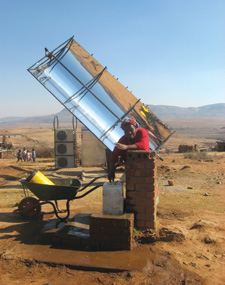Big Ideas
A thermal solar network using parabolic reflectors and old car parts. A boat that filters its own wastewater, has on-site wind power and educates passengers about the polluted waterway on which it floats. A car that runs on natural gas from local dairy cows. These are not breakthroughs from the world’s top scientists—they’re innovations from college students working with an increasing number of sustainable design programs in schools across the country.
Massachusetts Institute of Technology graduate student Matthew Orosz spent his two years in the Peace Corps in a village in Lesotho, located inside South Africa. He was impressed by a locally designed solar oven that used parabola-shaped reflectors to bake bread, and designed his own model that incorporated old car parts to make solar energy for electricity and hot water.
The project, the Solar Turbine Group (STG), received a $130,000 grant from the World Bank for two prototypes in Lesotho. One runs at the local high school in Bethel to supplement a diesel generator, and the other is in the village of Ha Teboho, where the solar panels are the only source of electricity and hot water. Orosz and fellow MIT engineers Amy Mueller and Libby Wayman spent 10 months in Lesotho working on the project.
The STG prototypes do not release any harmful emissions, Wayman says. Unlike conventional photovoltaic solar panels, his system collects heat energy from the sun to power a mechanical process that spins an auto alternator. “Electricity will really be beneficial to the villagers,” Wayman says. “Many people are excited that they can read and study at night, and the hot water will really improve the quality of life.”
Architecture, engineering and education students at the University of Virginia collaborated to design “The Learning Barge,” an idea from architecture professor Phoebe Crisman which won one of the Environmental Protection Agency 2007 People, Prosperity Planet (P3) awards. The students presented their work last year at the National Sustainable Design Expo in Washington, D.C.
The students’ design is for a floating classroom on Virginia’s Elizabeth River that uses on-site wind and solar power and filters its own wastewater using native plants. The university was one of six P3 winners, and its $75,000 award will be used to make a dramatic vision come true. Architecture student Danielle Willkens, a project veteran, says Crisman and his crew will have the barge operational this August.
The Elizabeth River, home to three Superfund sites, is one of the most polluted tributaries to Chesapeake Bay. Willkens says the Learning Barge will use sustainable technologies while teaching passengers about the imperiled river. “We hope they’ll take away knowledge of how sustainable systems work and how to apply these technologies to their own homes,” Willkens says.
The barge, made of recycled steel, will collect rainwater for hand washing with biodegradable soaps. There will be two composting toilets. “Essentially we’re going to be leaving the river cleaner than when we came,” Willkens says.

She says the barge represents a new course for architecture and design. “Starting work as a designer, you realize how much we take for granted,” Willkens says. “The resources we use are not going to be around forever.”
The annual contest also drew an entry from Western Washington University (WWU), powering a hybrid car with “biogas’ from local dairy farms. The Vehicle Research Institute (VRI) at WWU collaborated with Vander Haak Dairy in Lynden, Washington to turn methane gas from cow waste into clean fuel for Viking 32, a student-built hybrid vehicle. The dairy was the first in Washington State to use an anaerobic digester to capture methane.
WWU graduate Ryan Cruse, part of the 10-student award-winning hybrid team, says the digester essentially separates methane gas from the rest of the solid waste. In addition to powering a car, the gas can be collected and burned to generate electricity, which is then sold back to the electrical grid. The remaining solid waste can be used for fertilizer.
Pure methane is more than 20 times more effective than carbon dioxide (CO2) at trapping greenhouse gas in the atmosphere, Cruse says. “So by capturing it and burning it in a car, we make positive use of what would otherwise be a detrimental gas,” he says.
The hybrid team designed two gas “scrubbers’ that refine the biogas, removing hydrogen sulfide (which can corrode car parts) and CO2, Cruse says. The Viking 32 gets approximately 50 miles per gallon and its low emissions make it one of the cleanest cars on the road. The VRI will use its $75,000 grant from the P3 award to convert two local school buses to run on natural gas.
“Biomethane is a locally generated, locally used energy source,” Cruse says. “If we use all the cow waste in Whatcom County, that would replace 10 to 12 million gallons of gasoline.”
Programs like the VRI and University of Virginia’s sustainable architecture program are changing the direction of design. College students recognize the need to move toward sustainable technologies, and they’re taking the reins. “Hurricane Katrina and the Asian tsunami demonstrated dramatically that we have the potential to alter the environment,” Cruse says.

